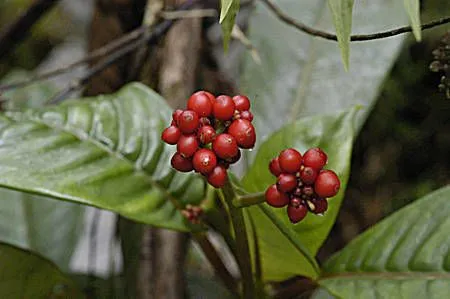
Author: Sw.
Bibliography: Prodr. Veg. Ind. Occ.: 43 (1788)
Year: 1788
Status: accepted
Rank: species
Genus: Psychotria
Vegetable: Unknown
Observations: Florida to Caribbean, S. Mexico to Ecuador
Seminole balsamo, scientifically known as Psychotria nervosa, is a noteworthy member of the Rubiaceae family. First described in the publication “Prodr. Veg. Ind. Occ.” in 1788 by the author Sw., this plant is renowned for its ecological and botanical significance.
This species flourishes across a diverse range of habitats, from Florida and the Caribbean down to southern Mexico and extending into Ecuador. Psychotria nervosa thrives in both coastal and inland areas, underscoring its adaptability to different environmental conditions.
The Seminole balsamo is a perennial shrub that can be recognized by its distinctive features. It exhibits lush green foliage, with its leaves often marked by prominent, parallel veins—a characteristic that hints at its scientific epithet, “nervosa”. These leaves are not only visually appealing but also serve a functional role in the plant’s overall health and growth.
In addition to its decorative leaves, Psychotria nervosa produces small, clustered flowers which, although not particularly showy, add to the plant’s overall charm. Following the flowering period, it bears small berries that can attract various bird species, playing a role in local ecosystems as a source of food and in the dispersal of seeds.
The distribution and growth of the Seminole balsamo across such a broad geographical range indicate its robustness and the ecological niches it occupies. Whether in a tropical forest undergrowth or as part of diverse plant communities, Psychotria nervosa contributes to the biodiversity and ecological balance of these regions.
Given its wide distribution and ecological adaptability, the Seminole balsamo is a plant of interest not only to botanists and ecologists but also to those advocating for conservation efforts. Its presence in varying habitats highlights the importance of preserving diverse ecosystems to ensure that such species continue to thrive.
Eng: seminole balsamo, bastard cankerberry, bastard canckerberry, wild coffee
Spa: bálsamo, palo moro
En: Seminole balsamo, Bastard Cankerberry, Bastard Canckerberry, Wild Coffee
Es: Bálsamo, Palo moro
Taken Jan 1, 1900 by EOL − Daniel H. Janzen (cc-by-nc-sa)
Taken Oct 8, 2008 by EOL − homeredwardprice (cc-by)
Taken Dec 29, 2012 by EOL − Jennifer Rycenga (cc-by-nc)
Taken Jan 17, 2016 by EOL − Damon Tighe (cc-by-nc)
Taken Jun 20, 2022 by Trap Hers (cc-by-sa)
Taken Jan 28, 2019 by Elly Hutchinson (cc-by-sa)
Taken Dec 17, 2021 by Collados Ana (cc-by-sa)
Taken Mar 1, 2022 by Anthony Bahuaud (cc-by-sa)
Taken Jun 20, 2022 by Trap Hers (cc-by-sa)
Taken Jan 14, 2021 by Samantha (cc-by-sa)
Taken Apr 18, 2021 by realjeep (cc-by-sa)
Taken May 31, 2022 by Gisela Salvatierra Soñanes (cc-by-sa)
Taken Jun 20, 2022 by Trap Hers (cc-by-sa)
Taken Jun 20, 2022 by Trap Hers (cc-by-sa)
Taken Apr 14, 2012 by EOL − Jason Sharp (cc-by-nc-sa)
Taken Dec 17, 2021 by Collados Ana (cc-by-sa)
Taken Apr 7, 2019 by julia salla (cc-by-sa)
Taken Oct 18, 2020 by kierstynn w (cc-by-sa)
Taken Nov 22, 2021 by tainaly tainaly macfie (cc-by-sa)
Taken Jan 1, 1900 by EOL − Acevedo, P. (cc-by-nc-sa)
Taken Nov 14, 2021 by Marzanna Bug (cc-by-sa)
Taken Nov 7, 2012 by OTS – Oviedo-Brenes, Federico (cc-by-nc-sa)
Taken Nov 7, 2012 by OTS – Oviedo-Brenes, Federico (cc-by-nc-sa)
Taken Jan 31, 2022 by Sébastien TRASBOT (cc-by-sa)
Taken Oct 15, 2019 by Diana (cc-by-sa)
© copyright of the Board of Trustees of the Royal Botanic Gardens, Kew.
© copyright of the Board of Trustees of the Royal Botanic Gardens, Kew.
© copyright of the Board of Trustees of the Royal Botanic Gardens, Kew.
Family: Myrtaceae Author: (F.Muell.) K.D.Hill & L.A.S.Johnson Bibliography: Telopea 6: 402 (1995) Year: 1995 Status:…
Family: Rubiaceae Author: Pierre ex A.Froehner Bibliography: Notizbl. Bot. Gart. Berlin-Dahlem 1: 237 (1897) Year:…
Family: Sapindaceae Author: Koidz. Bibliography: J. Coll. Sci. Imp. Univ. Tokyo 32(1): 38 (1911) Year:…
Family: Asteraceae Author: A.Gray Bibliography: Pacif. Railr. Rep.: 107 (1857) Year: 1857 Status: accepted Rank:…
Family: Fabaceae Author: Medik. Bibliography: Vorles. Churpfälz. Phys.-Ökon. Ges. 2: 398 (1787) Year: 1787 Status:…
Family: Aspleniaceae Author: (Cav.) Alston Bibliography: Bull. Misc. Inform. Kew 1932: 309 (1932) Year: 1932…